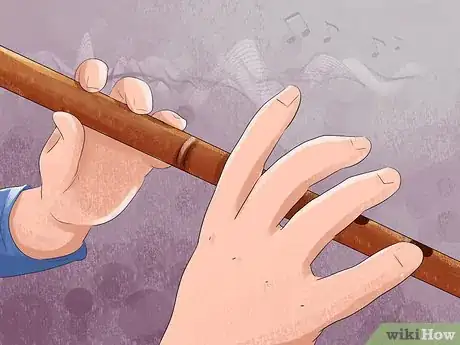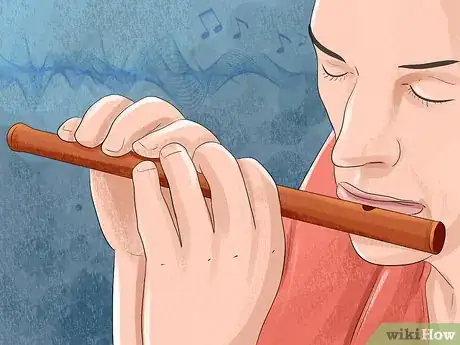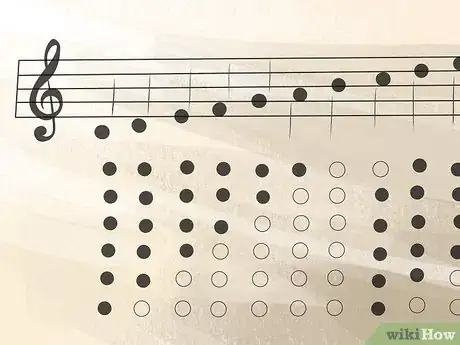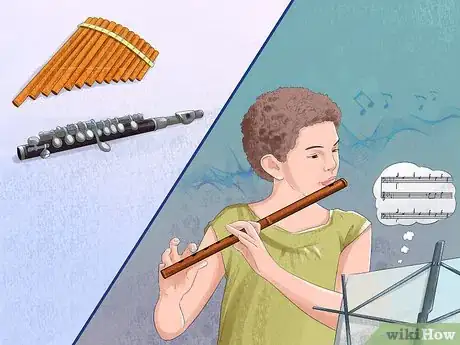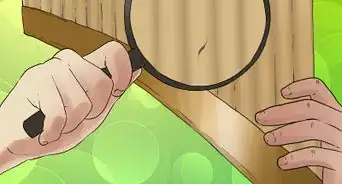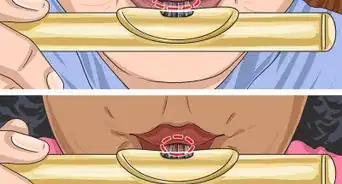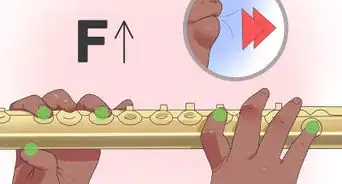This article was co-authored by wikiHow Staff. Our trained team of editors and researchers validate articles for accuracy and comprehensiveness. wikiHow's Content Management Team carefully monitors the work from our editorial staff to ensure that each article is backed by trusted research and meets our high quality standards.
This article has been viewed 90,770 times.
Learn more...
The fife is a wind instrument similar to a flute or piccolo, but without keys and with a higher, shriller sound. Originating in medieval Europe and used traditionally in the military, fifes are still played today in fife and drum corps and for individual enjoyment. Learn how to play this challenging but fun instrument yourself!
Steps
Holding and Blowing into the Fife
-
1Hold the instrument out to your right. Position the fife so that it is horizontal and extending out to the right of your face. The six holes for fingers should be out to the right, while the one hole on its own goes near your mouth for blowing.
Did You Know? "Fife" stands for five in the phonetic alphabet, which is a language used to communicate though radios to avoid misunderstandings.
-
2Place your hands correctly. Cover the three holes nearest to your mouth with the first three fingers of your left hand. Face the palm of that hand toward you. Cover the other three holes with the first three fingers of your right hand. Face the palm of that hand away from you.[1]
- Though the index, middle, and ring fingers of each hand will be the only ones covering holes, support the fife with the thumb and pinky fingers of both hands by resting them on the body of the instrument however they are comfortable.
- If your instrument is not the conventional 6-hole fife, you may have more holes to cover with your other fingers, but you can still use this basic hand placement.
Advertisement -
3Position your mouth for blowing. Place your bottom lip against the fife right next to the hole for blowing. Tighten your lips and try to blow across the hole rather than down into it.
- To get the right angle for your breath, imagine some of the air from your mouth is hitting the inner wall of the fife, and some is going past the blow hole outside the fife.[2]
- Try blowing out air as if you are whispering the word “too,” with lips tightened together and air pushed out sharply by your tongue.
-
4Practice blowing until you get a sound. Roll the instrument slowly back and forth while blowing to find the right angle to create a sound. Also try changing the angle of your breath and the tightness of your lips to find what makes the best sound.
- Practice blowing and holding the fife correctly by doing it in front of a mirror.[3]
- Don’t worry if it takes a long time to get your fife to make a sound! Keep experimenting with the angle of the fife and your lips until you can get a sound consistently.
Tuning and Learning Notes
-
1Tune the instrument first. Play the same note (you can start with all finger holes open) as another fife player or an electronic or online tuner to get the right pitch. Roll the instrument in toward your mouth if your note is too sharp. Roll it out if it is too flat. [4]
- Experiment rolling slowly in and out on the same note to hear how it changes in pitch. The pitch doesn’t matter so much if you’re just playing by yourself, but you’ll need to tune anytime you start playing with another fife or instrument.
-
2Try a low C#. Make a C sharp note by simply keeping all of the finger holes open and applying steady breath into the instrument. Roll the fife slightly in or out to see if it sounds sharp or flat compared to another player or a tuner.
- Try a middle C# by using the same fingering but blowing harder. Tighten your lips to push a harder stream of air from your mouth. This is generally how to achieve a note in a higher octave.
- Remember that these notes are for a standard fife, which has 6 holes and is in a Bb key. Look up notes and tuning for your specific instrument if it is in a different key or style.
-
3Try a low D. Play a D note by covering every finger hole and blowing an even, steady breath into the blow hole. Use this note to tune with another player or a tuner by rolling the fife further in or out from your mouth to change the pitch.
- Try to hold your fingers firmly over each hole, closing it completely to prevent air from getting through. Keep this in mind for every note you learn how to play.
- Remember that these notes are for a standard fife, which has 6 holes and is in a Bb key. Look up notes and tuning for your specific instrument if it is in a different key or style.
-
4Follow a fingering chart for the fife. Learn the proper fingering for nearly any note on the fife with a simple fingering chart. You may want to learn the basics of understanding musical notes, but you don’t have to.
- The typical complete fingering chart for a standard fife ranges from a low F (all but the second to last hole covered) to a high B (the first, third, and fifth hole covered).[5]
- Experiment with playing every note you can. Focus first on playing notes in a low or middle octave because they are easier to achieve when you’re just learning to blow and make a consistent sound.
- Some of the more difficult notes require half-closing a hole. You can either tilt your finger slightly so it doesn’t completely cover the hole, or you can “float” your finger above the hole so it doesn’t cover it so closely.[6]
Playing Songs
-
1Find sheet music. Locate sheet music for the fife online or at music stores. Use a fingering chart side by side with the sheet music to remember where to place your fingers for each note.
- You may be able to adapt music for another wind instrument—like a flute, piccolo, or panpipe—to play for the fife. Ask music store staff or someone familiar with wind instruments for help with this.
-
2Play music by ear. If you can’t or don’t want to read sheet music, you can also learn new songs simply by listening to them and sounding out the notes on your fife through trial and error, one note at a time.
- It will get easier to pick out notes once you have a better understanding of your instrument and practice picking up songs by ear. If you get stuck figuring out a note or section of notes, try moving on to a different part of the song.
-
3Breathe and take it slow. Take deep breaths and move slowly from note to note when you’re figuring out a song. It helps to stand up rather than sit down to play. Hold your head and shoulders up and your chest open to take big deep breaths.
- It can be very difficult and awkward at first to move your fingers from note to note. Be patient. Break the music down into small parts (just a few notes at a time), then repeat the same part over and over until you can move your fingers easily to each note before moving onto the next part.
-
4Join a fife and drum corps. Look up a fife and drum corps in your area. Join one of these groups to team up with other fife players and drummers to learn new songs, get valuable input and experience, and play in parades or historical events.
-
5Check with war reenactor groups. If you want to find another group to play with, and especially if you’re interested in the rich military history of fife music, talk to war reenactors about playing the fife for their reenactments or other events.
-
6Keep playing on your own. Continue to play just for yourself and improve by learning more from a teacher, an instructional book, or watching videos and looking up music online.
Community Q&A
-
QuestionDoes a fife have 8 fingerlings?
 Community AnswerA normal fife has one lip hole and six finger holes, however, some have ten finger holes.
Community AnswerA normal fife has one lip hole and six finger holes, however, some have ten finger holes. -
QuestionHow do I make sounds on a fife?
 Fire WraithCommunity AnswerYou blow across the embouchure hole like you would a flute. The noise should sound more like a piccolo's, though.
Fire WraithCommunity AnswerYou blow across the embouchure hole like you would a flute. The noise should sound more like a piccolo's, though.
Warnings
- You may get winded when learning to blow into your fife and play strings of notes. Stop to take breaks and sit down if you feel lightheaded. You will soon build up stamina and better lung capacity.⧼thumbs_response⧽
References
- ↑ http://www.traditionalmusic.co.uk/its-easy-to-make-music/make-music-0145.htm
- ↑ http://www.traditionalmusic.co.uk/its-easy-to-make-music/make-music-0145.htm
- ↑ http://www.beafifer.com/
- ↑ http://www.beafifer.com/
- ↑ http://www.oldflutes.com/articles/fife/
- ↑ http://mfleck.cs.illinois.edu/flute-tips.html

